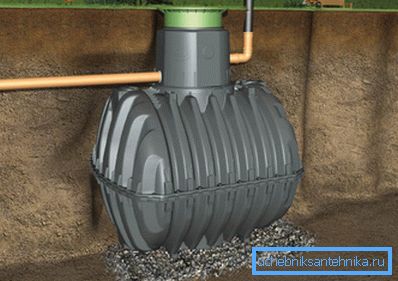Autonomous sewage in a private house: the choice of the best
Many country houses, built with their own hands, do not imply the possibility of connecting to the sewer line. Therefore, the owners of such property sooner or later face the issue of building an autonomous system for the discharge of wastewater and other waste.
In this article, we will look at the most popular varieties of sewer systems today, which can be used in the construction of a country house. So, what to choose from?

Main varieties

Currently, three types of sewers are ubiquitous:
- Industrial systems, intended for the collection and subsequent treatment of effluents at industrial facilities;
- Storm systems, intended for the discharge of effluents formed by precipitation;
- Household systems, intended for servicing settlements (centralized) and for servicing a single individual building housing object (autonomous).
With regard to the arrangement of a country house and the surrounding area we are interested in the household and storm modification. Using these types of sewage can completely solve the problem of high-quality disposal and disposal of wastewater.
The household system, in turn, is divided into two categories:
- Interior equipment - includes all plumbing devices and household piping located inside the construction site.
- External equipment - pumping station is represented by sewage treatment plants and pipelines located outside the construction site.
Autonomous sewage of a private outdoor house, in turn, is represented by the following modifications:
- Separate system in which economic and rain drains are discharged separately;
- A semi-partition system in which the discharge of wastewater is carried out separately, but, ultimately, all drains are combined in a single cleansing collector;
- A combined system in which household, industrial and rain drains are discharged together.
Autonomous sewage for a private house, in accordance with the method of wastewater, is divided into the following modifications:
- Gravity - the abduction is carried out by the inclination of the pipeline
- Forced, where the discharge of the liquid medium is carried out using pumping equipment.
Sewerage used in country houses is rarely equipped with centralized equipment for the collection, storage and disposal of waste and waste.
The following autonomous wastewater disposal systems are most commonly used:
- cesspool - the cheapest and at the same time the most inconvenient type of sewage system;
- dry closet - a good option for a small cottage, but not for a full-fledged country house;
- the drainage system is a unique structure, as it is distinguished by high efficiency of use, reasonable price and the possibility of building with your own hands;
- a septic tank is an acceptable option, both in terms of cost and in terms of operating efficiency;
- Biological wastewater and wastewater treatment plants are the most progressive and efficient option for equipping a full-fledged country house.
Consider the structure and operation of the above systems in more detail.
Drainage system and features of its functioning

In essence, the drainage system constructively resembles a cesspool, but with the difference that the drainage sewer is larger and deeper, and in addition, it uses a natural filter. This type of sewage is used exclusively for the disposal of liquid media, and therefore is built on those areas where the groundwater is deeply deposited.
The natural filter consists of several alternating layers of sand, fine gravel and geotextile. The drains, getting into the natural filter, pass through several layers, are partially cleaned and pass deeper, where they are combined with groundwater.
Systems equipped with a natural filter will be a great solution for recycling water used in a washbasin, in a bath or in a summer shower.
Important: In order to eliminate the likelihood of a biological threat to a local ecosystem, drainage sewage should not be used to discharge waste from a toilet.

The device of drainage storm sewage provides the possibility of discharge of atmospheric and melt water from the infield.
The construction instruction of such a system provides for digging trenches of the required depth (depth and width are determined in accordance with the diameter of the pipes used). The length of the trenches should be at least 2 meters. Drill holes in several rows of pipes at a distance of several centimeters from each other.
The pipes prepared in this way are laid in trenches and filled with gravel, and on top with ordinary soil, so that the surface of the backfill is either flush with the soil surface or slightly higher.
The operation of this type of storm sewer is as follows. Water fills the internal volume of the pipe and gradually through the drilled holes and the bottom of the soil goes into the gravel backfill and into the soil.
Important: The length and diameter of pipes must be selected in accordance with the level of precipitation in the region.
Cesspit

This method of disposal of wastewater involves the construction of a natural reservoir - a recess in the ground and a surface cover or superstructure in the form of a booth with a toilet seat.
As exploited, the natural reservoir is filled with waste. Therefore, regularly, for example, once every six months, the contents of the tank must be pumped out and transported to specially designated areas or to enterprises specializing in waste processing. For this purpose, ashenizatorskaya machine is used, equipped with a compressor unit.
Septic tank

An excellent alternative to cesspools can serve as a septic tank. The septic tank can be purchased ready-made, or it can be assembled by hand from reinforced concrete rings or bricks. The most promising choice is to purchase a ready-made plastic septic tank, which is installed in a specially dug pit, filled with soil and is almost imperceptible from a distance.

Septic tank is a multi-chamber with a complex system of iridescent pipes.
The functioning of the septic tank is as follows:
- The sewage flows through the sewer pipe into the first chamber of the septic tank, where the primary sedimentation and removal of heavy particles takes place.
- Further, the drains pass into the next chamber, where fat particles gradually float to the surface.
- Partially treated effluents pass into the next chamber, where sedimentation of the remaining heavy particles occurs.
- At the final stage, the liquid medium is discharged to the outside and drained into the nearest reservoir or drainage well.
Bio sewage works in a similar way, but with the difference that waste is not only settled, but also processed by special microorganisms.
Conclusion
So, we looked at the autonomous sewage system in a private house, now it remains to choose the option that can be applied at your summer cottage.
Are there any questions that require comprehensive answers? In this case, more useful information you can find by watching the video in this article.